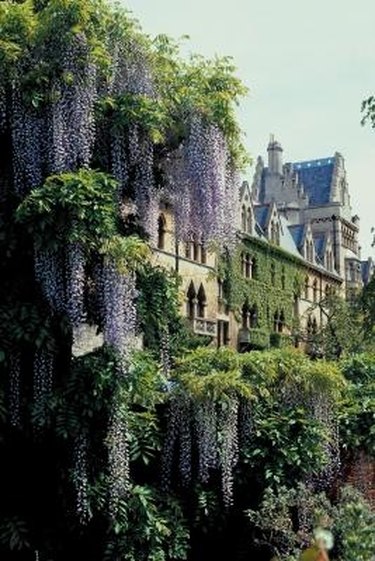
Wisteria is a vigorous, extravagant vine, producing clusters of blue, purple, pink or white flowers 12 inches or more in length. The plant has a short bloom period, but its corky bark, velvet seed pods and yellow fall foliage make up for flowers the rest of the year. Provide a sturdy trellis where the wisteria will grow for 40 years or longer.
Bloom Time
Video of the Day
Wisteria blooms from early to mid-spring -- typically three to four weeks, depending on the variety. The blooms of Japanese wisteria open slowly, from top to bottom, and bloom longer than Chinese wisteria. However, their slow opening makes them lack the visual impact of Chinese wisteria.
Video of the Day
Time Frame
Chinese wisteria bloom in early spring, producing prolific flowers before the leaves emerge. Hardier Japanese wisteria blooms in late spring, also before leaves emerge. W. x formosa is a hybrid of Japanese and Chinese wisteria. This plant blooms in late spring, as well, and combines the hardiness of the Japanese wisteria with the flowering pattern of the Chinese wisteria.
Challenges
In addition to a short bloom time, getting wisterias to bloom at all can be difficult. Grafted or layered wisteria do not produce flowers until they are at least 5 and up to 10 years old. Plants grown from seed take even longer. The buds are often killed by late frosts in cold regions, eliminating the flowers for one season. Occasionally, wisteria refuses to bloom because of an actively spreading root system.
Solutions
To encourage wisteria to bloom, even for only a few weeks, plant it in a well-protected area, such as near a building in full sun. Prune the plant after it blooms to remove new growth and control its heavy limbs. Dig 18 inches deep into the soil in a circle 2 feet from the base of the plant every fall. This activity severs some of the roots so the plant focuses on blossom development, rather than root development. Fertilize wisteria with 1 lb. of superphosphate fertilizer per plant in late spring. Avoid nitrogen fertilizer, which encourages foliage, rather than blooms.